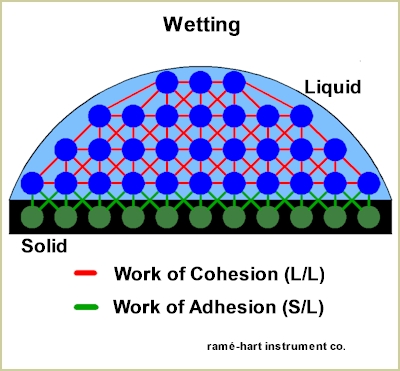|
March 2020 |
|
| Adhesion and Contact Angle - A Primer | |
|
Adhesion is one of those things that
no one seems to fully understand but everyone appreciates when it
works. And when it doesn't work, it can be a problem...and sometimes an expensive
one. Just ask US
Air Force Captain Ronald Halley. The A-10 jet he was flying
during training experienced failure which resulted in the plane
going down. Halley was able to eject but the $10.2 million jet crashed and burned.1
What caused this catastrophe? A simple piece of Velcro failed. Velcro is an example of mechanical interlocking. Think Lego blocks, Ziploc bags, and zippers. Mechanical interlocking can also be achieved with an adhesive that is applied to a rough surface and allowed to seep into all of the nooks and crannies to create a strong physical bond. The roughness also increases the bondable surface area. Do you remember repairing a bicycle inner tube when you were a kid? The kit has a little metal scuffer used to rough up the surface of the inner tube before applying rubber cement. The purpose of that step is to improve mechanical interlocking. Chemical bonding occurs when the atoms on two different non-metal surfaces share electrons. This is called covalent bonding. When the atoms of the two surfaces swap electrons, it's called ionic bonding. When a hydrogen atom is attracted to an atom in another molecule, it's called hydrogen bonding. For all types of chemical bonding to be effective, the two surfaces must be brought close together and the resulting bond is rather brittle. That brings us the grandmaster of adhesion: adsorption. Without adsorptive adhesion, many bonding applications would not occur or would fail. Adsorption counts on a variety of interactions and forces2 between molecules. For good bonding to occur, the molecules of the adherent material must make intimate and molecular contact with the substrate. In fact, if the adherent and substrate are more than a few angstroms apart, the adsorptive forces are too weak to result in bonding. In surface science, when we refer to adhesion, we are almost always referring to adsorption. With a solid, liquid, gas environment - like a drop of liquid on a solid illustrated below - the solid must have higher surface energy than the liquid in order for good wetting and good adsorptive adhesion to occur. There are two competing forces in this arrangement: the force between the liquid's molecules - shown in red - the cohesive force, or the work of cohesion; and the adhesive force between the solid's molecules and the liquid's molecules - shown in green, or the work of adhesion. When the work of adhesion is stronger than the work of cohesion, wetting is good and adhesion is optimal. If the surface is dirty, oily, or otherwise contaminated, wetting will be exacerbated which results in poor adhesion.
Since high surface energy is ideal for adhesion, many materials - such as silicone rubber, fluoropolymers like PTFE, and polypropylene - which have unusually low surface energy, may require surface treatments that will increase surface energy. The result is improved adhesion not just for bonding adhesives (e.g., epoxies and acrylics) but also coatings (e.g., inks and paints). Corona treatment, for example, is a common method used to disrupt the molecules on the surface of the polymer solids through oxidation which leads to higher surface energy and better bonding. Other surface treatment methods include gas plasma and flame treatment and ultra-violet irradiation. Naturally, contact angle is the universal method for measuring surface energy. However, static contact angle alone offers only a one-dimensional view of wetting behavior. By capturing the entire range of possible equilibrium contact angles, it's possible to determine the maximum and minimum contact angles - commonly referred to as the advancing and receding contact angles. The advancing contact angle is driven by the cohesive forces in the liquid and the relatively weak surface energy components of the solid surface while the receding contact angle is more sensitive to the adhesive forces between the adherent and solid which is driven by the oxidized (i.e., treated) and high surface energy components of the substrate. The tilting base method is the most common and reliable method used for capturing the advancing and receding contact angle. Contact angle hysteresis is used to determine how homogenous a surface is. A small contact angle hysteresis indicates a high level of homogeneity relative to both the chemical and structural composition of the surface. In general, a low contact angle hysteresis may be desirable for chemical bonding while a larger contact angle hysteresis may be desirable for mechanical interlocking and other bonding applications. However, contact angle hysteresis must be optimized for the particular industrial process. Dip coating, for example, benefits from and requires high contact angle hysteresis while other processes such as photolithography work best with minimal contact angle hysteresis. Engineers and material scientists interested in adhesion, especially polymeric bonding will find a basic understanding of wetting properties and contact angle critical to developing and improving bonding applications and methods, reducing bonding failure, and improving product quality. ramé-hart instrument company is the world leader in contact angle tools used for measuring contact angle, advancing and receding contact angles as well as surface energy - and much more. Bullets
1 See this
AP News Story. |
|
| WAC 2020 | |
| If you're involved with adhesive and bonding applications, registration is currently open for the 2020 World Adhesive & Sealant Conference which will be held 20 to 22-April-2020 in Chicago. To learn more or to register, visit https://wac2020.org/. | |
|
Regards,
Carl Clegg |
|

